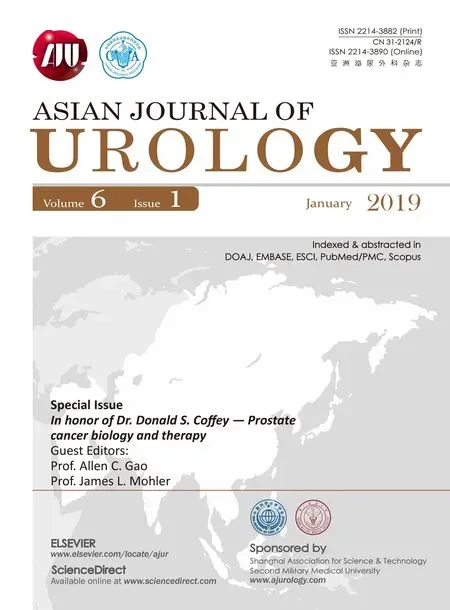In honor of Dr.Donald S.Coffey-Prostate cancer biology and therapy
This special issue of the Asian Journal of Urology(AJU)is dedicated to Donald S.Coffey,Ph.D.who passed away on Nov.9,2017.Dr.Coffey,professor at Johns Hopkins University,made monumental impacts on the advancement of urological research and the lives of people around him in and out of the urological research community.Dr.Coffey played an essential role in the Society for Basic Urologic Research(SBUR)as a devoted member and former president.We have collected 11 articles written by former students,trainees,fellows and colleagues of Dr.Coffey that cover a wide range of topics considered to be of prime interest to Dr.Coffey,which include the genetics,diagnosis,and treatment of advanced prostate cancer(PCa).
Dramatic progress has been made in of germline genetics of PCa in the past decade.For men with high risk PCa,the application of genetic testing for inherited pathogenic mutations is becoming standard of care.A major question exists aboutwhichadditionalpopulationsofmen totest,sincemen at all risk levels may benefit by knowing their unique genetic profile of germline susceptibility variants.Drs.William B.Isaacs and Jianfeng Xu[1]provided a brief overview of some issues in understanding inherited susceptibility for PCa.
Two articles described the use of antibodies for diagnostics and research in PCa.Dr.Andelo M.De Marzo and colleagues[2]argued that researchers fail to realize that there are two general classes of antibodies used for immunohistochemistry(IHC).Those antibodies that are“clinical grade”reagents are validated carefully prior to clinical implementation.Clinical grade antibodies are used by pathologists to help render diagnoses that in fluence patient treatment but are few in number(<500).The other main class of antibodies are “research grade” antibodies(>3 800 000),which are often not validated well prior to commercialization.Dr.Jun Luo and his colleagues[3]described the detection of androgen receptor(AR)and AR-V7 in small cell prostate carcinoma(SCPC)using IHC on post-androgen deprivation therapy(ADT)surgical SCPC specimens.
Current mainstream therapies for advanced PCa are targeting AR signaling.ADT is the most effective initial treatment for patients,however,after the initial response,almost all patients will eventually progress to castrationresistant prostate cancer(CRPC).Dr.Kenneth Pienta and colleagues[4]provided an overview of current treatments for CRPC and summarized recent findings in therapeutic resistance mechanisms.Dr.Allen C.Gao and colleagues[5]provided an overview of the mechanisms of resistance associated with the most relevant AR variants,and discussed current AR variant targeting strategies including a phase II clinical trial testing niclosamide as an AR-V7 targeting agent for CRPC.Another mechanism for PCa recurrence relies on intratumoral synthesis of dihydrotestosterone(DHT),which can be synthesized using the frontdoor,primary backdoor,or secondary backdoor pathway.Dr.James L.Mohler and his colleagues[6]described the therapeutic potential of combined inhibition of 5α-reductase and 3α-oxidoreductase enzymes that facilitate the terminal steps of these pathways for DHT synthesis.Inhibition of the terminal steps of the androgen metabolism pathways may be a way to overcome the shortcomings of existing androgen metabolism inhibitors and thereby delay PCa recurrence during ADTor enhance the response of CRPC to androgen axis manipulation.
Targeting other potent resistance mechanisms have showed promising results in experimental studies.Dr.David Jarrard and colleagues[7]examined the response to ADT and the putative role of cellular senescence as a biomarker and therapeutic target during ADT.Senescent tumor cells generate a catabolic state with increased glycolysis,protein turnover and other metabolic changes that represent targets for drugs,like metformin,to be applied in a synthetic lethal approach.Dr.Leland W.K.Chung and colleagues[8]described the cellsignaling network of metastatic PCa to bone and visceral organs in the context of tumor microenvironment.These works provide new targets for treatment and new insights into the basic science of PCa metastasis.
AR negative forms of PCa do not respond to AR-targeted therapy.A classic example is neuroendocrine PCa(NEPC),which can occur de novo or,more commonly,as CRPC who have been treated with the newer and more effective AR-targeted therapies.NEPC is increasingly recognized as a subset of CRPC,which demonstrates resistance to both abiraterone and enzalutamide.Dr.Natasha Kyprianou and colleagues[9]showed compelling evidence that chemotherapy(cabazitaxel,second line taxane chemotherapy),or transforming growth factor β (TGF-β)receptor signaling targeted therapy,caused reversion of epithelial-mesenchymal transition(EMT)to mesenchymal-epithelial transition(MET)and tumor re-differentiation in vitro and in vivo PCa models.The functional contribution of EMT dynamic changes to the development of the neuroendocrine phenotype changes in the context of tumor microenvironment-navigated cell lineage.The role of this neuroendocrine phenotype in metastaticprogression and therapeutic resistance are discussed. Dr.Jiaoti Huang and colleagues[10]overviewed the novel AR-independent pathways that contribute to PCa carcinogenesisandprogression.These AR-independentpathways include neuroendocrine differentiation,cell metabolism,DNA damage repair pathways and immune-mediated mechanisms.The development of novel agents targeting non-AR mechanisms holds great promise to treat PCa that does not respond to AR-targeted therapies.Finally,Dr.John T.Isaacs and colleagues[11]described novel systemic therapeutics that sterilize the entire microenvironment in metastatic CRPC(mCRPC).This novel approach is based on albuminlinked prostate-specific antigen (PSA)-activated thapsigargin-and niclosamide-based molecular grenades targeting the microenvironment in mCRPC.
One of Dr.Coffey’s favorite aphorisms was “If this is true,what does it imply?”.This philosophy inspires many of us to keep pursuing the solutions to the challenges facing those who suffer from urological diseases,particularly PCa.We hope that this special issue of articles in tribute to Dr.Coffey will continue his spirit of sharing,loving,and curiosity about science.

